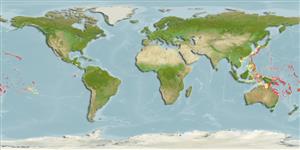Actinopterygii (ray-finned fishes) >
Perciformes (Perch-likes) >
Labridae (Wrasses) > Cheilininae
Etymology: Cirrhilabrus: Latin, cirrus = curl fringe + Greek, labros = furious (Ref. 45335). More on author: Randall.
Environment / Climate / Range
Ecology
Marine; reef-associated; depth range 2 - 78 m (Ref. 86942), usually 5 - 28 m (Ref. 27115). Tropical; 24°C - 28°C (Ref. 27115), preferred ?
Western Pacific: New South Wales, Australia to southern Guinea, Fiji and Tonga.
Size / Weight / Age
Maturity: Lm ? range ? - ? cm
Max length : 13.0 cm TL male/unsexed; (Ref. 2334)
Dorsal
spines
(total): 11;
Dorsal
soft rays
(total): 9;
Anal
spines: 3;
Anal
soft rays: 9. Pelvic fins in male very long, often half or more of standard length. Upper three-fourths of the body dark gray to reddish with pink to blue dots, lower fourth white; a black spot at the base of the pectoral fins; females and juveniles with a black spot at the upper base of the caudal fin.
Found over coral or rubble of shallow protected reefs, occasionally in exposed areas (Ref. 9710).
Life cycle and mating behavior
Maturity | Reproduction | Spawning | Eggs | Fecundity | Larvae
Distinct pairing during breeding (Ref. 205).
Randall, J.E., G.R. Allen and R.C. Steene, 1990. Fishes of the Great Barrier Reef and Coral Sea. University of Hawaii Press, Honolulu, Hawaii. 506 p. (Ref. 2334)
IUCN Red List Status (Ref. 115185)
CITES (Ref. 94142)
Not Evaluated
Threat to humans
Harmless
Human uses
Aquarium: commercial
More information
ReferencesAquacultureAquaculture profileStrainsGeneticsAllele frequenciesHeritabilityDiseasesProcessingMass conversion
Tools
Special reports
Download XML
Internet sources
